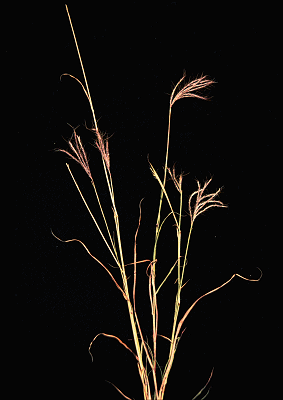 |
 |
|
 |
 |
|

Bothriochloa ewartiana (Domin) C.E.Hubb. |
Common name
Desert Bluegrass
Derivation
Bothriochloa Kuntze, Revis. Gen. Pl. 2: 762 (1891); from the Greek
bothros (pit) and chloa (grass), alluding to the pitted glumes.
ewartiana- after the English-born Australian botanist, Albert James Ewart (1872–1937).
Published in
Bull. Misc. Inform. 444 (1934).
Habit
Perennial, tufted. Basal leaf sheaths glabrous or pilose. Culms erect or geniculately
ascending, 30–60 cm tall, 6–9-noded. Mid-culm internodes channelled.
Lateral branches simple or sparsely branched or branched. Leaf-sheaths glabrous
on surface. Ligule a fringed membrane, truncate. Leaf-blades flat or conduplicate
or revolute, 7–15 cm long, 3–6 mm wide, glaucous. Leaf-blade midrib
conspicuous. Leaf-blade surface glabrous or pilose, with tubercle-based hairs.
Leaf-blade margins cartilaginous.
Inflorescence
Inflorescence subdigitate, with ramose branches. Peduncle 2.5–7 cm long.
Racemes 4–11, 3.5–7 cm long. Central inflorescence axis 1–2.5
cm long. Rhachis fragile at the nodes, flattened, villous on margins. Rhachis
hairs 3.5 mm long. Raceme internodes linear, 2–2.5 mm long, 50% length
of fertile spikelet. Raceme internode tip transverse. Raceme-bases linear, 2–7
mm long.
Spikelets
Spikelets in pairs, one sessile and fertile and the other (companion) spikelet
pedicelled. Pedicels linear, flattened, 2–2.5 mm long, 50% of length
of fertile spikelet, with a translucent median line (also present in internodes),
villous, with 3.5 mm long hairs. Companion spikelets developed, female or male
(rarely), containing empty lemmas or male, lanceolate, 3.5–4.5 mm long,
as long as fertile. Companion spikelet glumes without depressions, glabrous.
Companion spikelet lemmas enclosed by glumes. Fertile spikelets 2-flowered,
comprising 1 fertile floret, lower floret sterile, upper fertile, without rhachilla
extension, elliptic or oblong or oblanceolate, dorsally compressed, subacute,
3.5–4.5 mm long, falling entire, deciduous with accessory branch structures.
Spikelet callus pilose, base obtuse, attached transversely.
Glumes
Glumes dissimilar, firmer than fertile lemma. Lower glume elliptic, 100%
of length of spikelet, chartaceous, keel-less except near apex, 9–11-nerved.
Lower glume surface flat. Lower glume surface without pits or pitted, pilose,
hairy below. Lower glume apex obtuse or acute. Upper glume lanceolate, 1-keeled.
Upper glume margins ciliate.
Florets
Basal sterile floret 1, without significant palea. Lemma of lower sterile floret
oblong, 66% of length of spikelet, hyaline. Fertile lemma linear, hyaline.
Lemma apex entire, 1-awned. Median (principal) awn apical, geniculate, 17–25
mm long overall, with a twisted column. Column glabrous. Palea absent or minute.
Anthers 3, 1.5–2 mm long. Grain oblanceolate, 2.5 mm long.
Continental Distribution:
Australasia.
Australian Distribution:
Western Australia, Northern Territory, South Australia, Queensland, New South
Wales.
Western Australia: Gardner, Fitzgerald, Hall, Dampier, Canning, Keartland, Giles, Fortescue, Ashburton, Carnarvon, Austin, Irwin. Northern Territory: Darwin & Gulf, Victoria River, Barkly Tableland, Central Australia North, Central Australia South. South Australia: North-western, Lake Eyre, Gairdner-Torrens Basin, Flinders Ranges, Northern Lofty. Queensland: Cook, Burke, North Kennedy, South Kennedy, Port Curtis, Leichhardt, Darling Downs, Gregory North, Gregory South, Mitchell, Warrego, Maranoa. New South Wales: North-Western Slopes, North-Western Plains.
Classification. (GPWG
2001):
Panicoideae: Andropogoneae
Notes
Endemic. A valuable drought resistant fodder grass of the drier grasslands and
Eucalyptus forests. Found in all mainland states except Vic. Flowers
all year.

Inflorescence (photo)
© E.Anderson